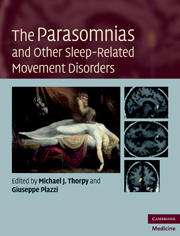Book contents
- The Parasomnias and Other Sleep-Related Movement Disorders
- The Parasomnias and Other Sleep-Related Movement Disorders
- Copyright page
- Contents
- Contributors
- Preface
- Credits and Acknowledgments
- Foreword
- Section 1 Introduction
- Section 2 Disorders of arousal
- Section 3 Parasomnias usually associated with REM sleep
- Section 4 Other parasomnias
- Section 5 Sleep-related movement disorders and other variants
- Section 6 Therapy of parasomnias
- Chapter 31 Pharmacotherapy and parasomnias
- Chapter 32 Behavioral and psychiatric treatment of parasomnias
- Chapter 33 Hypnotherapy and parasomnias
- Index
Chapter 31 - Pharmacotherapy and parasomnias
from Section 6 - Therapy of parasomnias
Published online by Cambridge University Press: 10 November 2010
- The Parasomnias and Other Sleep-Related Movement Disorders
- The Parasomnias and Other Sleep-Related Movement Disorders
- Copyright page
- Contents
- Contributors
- Preface
- Credits and Acknowledgments
- Foreword
- Section 1 Introduction
- Section 2 Disorders of arousal
- Section 3 Parasomnias usually associated with REM sleep
- Section 4 Other parasomnias
- Section 5 Sleep-related movement disorders and other variants
- Section 6 Therapy of parasomnias
- Chapter 31 Pharmacotherapy and parasomnias
- Chapter 32 Behavioral and psychiatric treatment of parasomnias
- Chapter 33 Hypnotherapy and parasomnias
- Index
Summary
Keywords
- Type
- Chapter
- Information
- The Parasomnias and Other Sleep-Related Movement Disorders , pp. 301 - 311Publisher: Cambridge University PressPrint publication year: 2010

